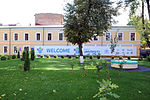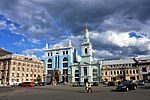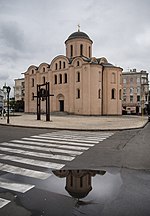Kiev Naval Political College

Kyiv Naval Political College (Ukrainian: Київське вище військово-морське політичне училище, КВВМПУ) was a State military institution of higher education. It was the only school in the whole Soviet Union that was preparing political commissars for the Soviet Navy. The college was established on 21 January 1967 by Central Committee of the Communist Party of the Soviet Union. In 1948 to 1957 there existed Kyiv Naval Political School. The institution was located in the building that used to be a headquarters of the Soviet Dnieper Flotilla which in turn took it away from the Kiev Theological Academy. In 1995 the college was closed and dissolved. Its building was transferred to the newly established National University of Kyiv-Mohyla Academy that claims to be a descendant of the Old Kyiv Mohyla Academy (1632-1817). The mosaic with the college's symbol was preserved by the administration of new university. It contains two quotes of the Soviet Union and Communist leader, Vladimir Lenin: "Study, study, study..." and "Party is brains, honor and conscience of our epoch".
Excerpt from the Wikipedia article Kiev Naval Political College (License: CC BY-SA 3.0, Authors, Images).Kiev Naval Political College
Illinska Street, Kyiv Podil
Geographical coordinates (GPS) Address Phone number Website Nearby Places Show on map
Geographical coordinates (GPS)
| Latitude | Longitude |
|---|---|
| N 50.465 ° | E 30.5192 ° |
Address
Національний університет «Києво-Могилянська академія»
Illinska Street
04070 Kyiv, Podil
Ukraine
Open on Google Maps










